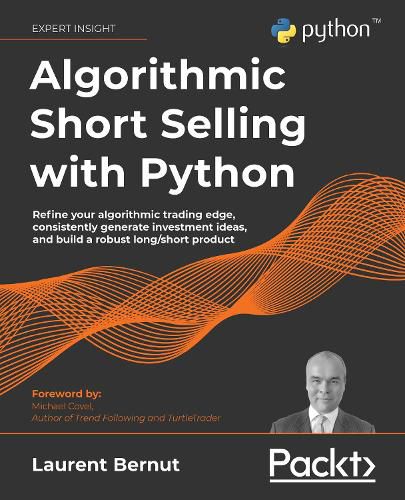Readings Newsletter
Become a Readings Member to make your shopping experience even easier.
Sign in or sign up for free!
You’re not far away from qualifying for FREE standard shipping within Australia
You’ve qualified for FREE standard shipping within Australia
The cart is loading…






This title is printed to order. This book may have been self-published. If so, we cannot guarantee the quality of the content. In the main most books will have gone through the editing process however some may not. We therefore suggest that you be aware of this before ordering this book. If in doubt check either the author or publisher’s details as we are unable to accept any returns unless they are faulty. Please contact us if you have any questions.
Leverage Python source code to revolutionize your short selling strategy and to consistently make profits in bull, bear, and sideways markets
Key Features
Understand techniques such as trend following, mean reversion, position sizing, and risk management in a short-selling context Implement Python source code to explore and develop your own investment strategy Test your trading strategies to limit risk and increase profits
Book DescriptionIf you are in the long/short business, learning how to sell short is not a choice. Short selling is the key to raising assets under management. This book will help you demystify and hone the short selling craft, providing Python source code to construct a robust long/short portfolio. It discusses fundamental and advanced trading concepts from the perspective of a veteran short seller.
This book will take you on a journey from an idea ( buy bullish stocks, sell bearish ones ) to becoming part of the elite club of long/short hedge fund algorithmic traders. You’ll explore key concepts such as trading psychology, trading edge, regime definition, signal processing, position sizing, risk management, and asset allocation, one obstacle at a time. Along the way, you’ll will discover simple methods to consistently generate investment ideas, and consider variables that impact returns, volatility, and overall attractiveness of returns.
By the end of this book, you’ll not only become familiar with some of the most sophisticated concepts in capital markets, but also have Python source code to construct a long/short product that investors are bound to find attractive.
What you will learn
Develop the mindset required to win the infinite, complex, random game called the stock market Demystify short selling in order to generate alpa in bull, bear, and sideways markets Generate ideas consistently on both sides of the portfolio Implement Python source code to engineer a statistically robust trading edge Develop superior risk management habits Build a long/short product that investors will find appealing
Who this book is forThis is a book by a practitioner for practitioners. It is designed to benefit a wide range of people, including long/short market participants, quantitative participants, proprietary traders, commodity trading advisors, retail investors (pro retailers, students, and retail quants), and long-only investors.
At least 2 years of active trading experience, intermediate-level experience of the Python programming language, and basic mathematical literacy (basic statistics and algebra) are expected.
$9.00 standard shipping within Australia
FREE standard shipping within Australia for orders over $100.00
Express & International shipping calculated at checkout
This title is printed to order. This book may have been self-published. If so, we cannot guarantee the quality of the content. In the main most books will have gone through the editing process however some may not. We therefore suggest that you be aware of this before ordering this book. If in doubt check either the author or publisher’s details as we are unable to accept any returns unless they are faulty. Please contact us if you have any questions.
Leverage Python source code to revolutionize your short selling strategy and to consistently make profits in bull, bear, and sideways markets
Key Features
Understand techniques such as trend following, mean reversion, position sizing, and risk management in a short-selling context Implement Python source code to explore and develop your own investment strategy Test your trading strategies to limit risk and increase profits
Book DescriptionIf you are in the long/short business, learning how to sell short is not a choice. Short selling is the key to raising assets under management. This book will help you demystify and hone the short selling craft, providing Python source code to construct a robust long/short portfolio. It discusses fundamental and advanced trading concepts from the perspective of a veteran short seller.
This book will take you on a journey from an idea ( buy bullish stocks, sell bearish ones ) to becoming part of the elite club of long/short hedge fund algorithmic traders. You’ll explore key concepts such as trading psychology, trading edge, regime definition, signal processing, position sizing, risk management, and asset allocation, one obstacle at a time. Along the way, you’ll will discover simple methods to consistently generate investment ideas, and consider variables that impact returns, volatility, and overall attractiveness of returns.
By the end of this book, you’ll not only become familiar with some of the most sophisticated concepts in capital markets, but also have Python source code to construct a long/short product that investors are bound to find attractive.
What you will learn
Develop the mindset required to win the infinite, complex, random game called the stock market Demystify short selling in order to generate alpa in bull, bear, and sideways markets Generate ideas consistently on both sides of the portfolio Implement Python source code to engineer a statistically robust trading edge Develop superior risk management habits Build a long/short product that investors will find appealing
Who this book is forThis is a book by a practitioner for practitioners. It is designed to benefit a wide range of people, including long/short market participants, quantitative participants, proprietary traders, commodity trading advisors, retail investors (pro retailers, students, and retail quants), and long-only investors.
At least 2 years of active trading experience, intermediate-level experience of the Python programming language, and basic mathematical literacy (basic statistics and algebra) are expected.